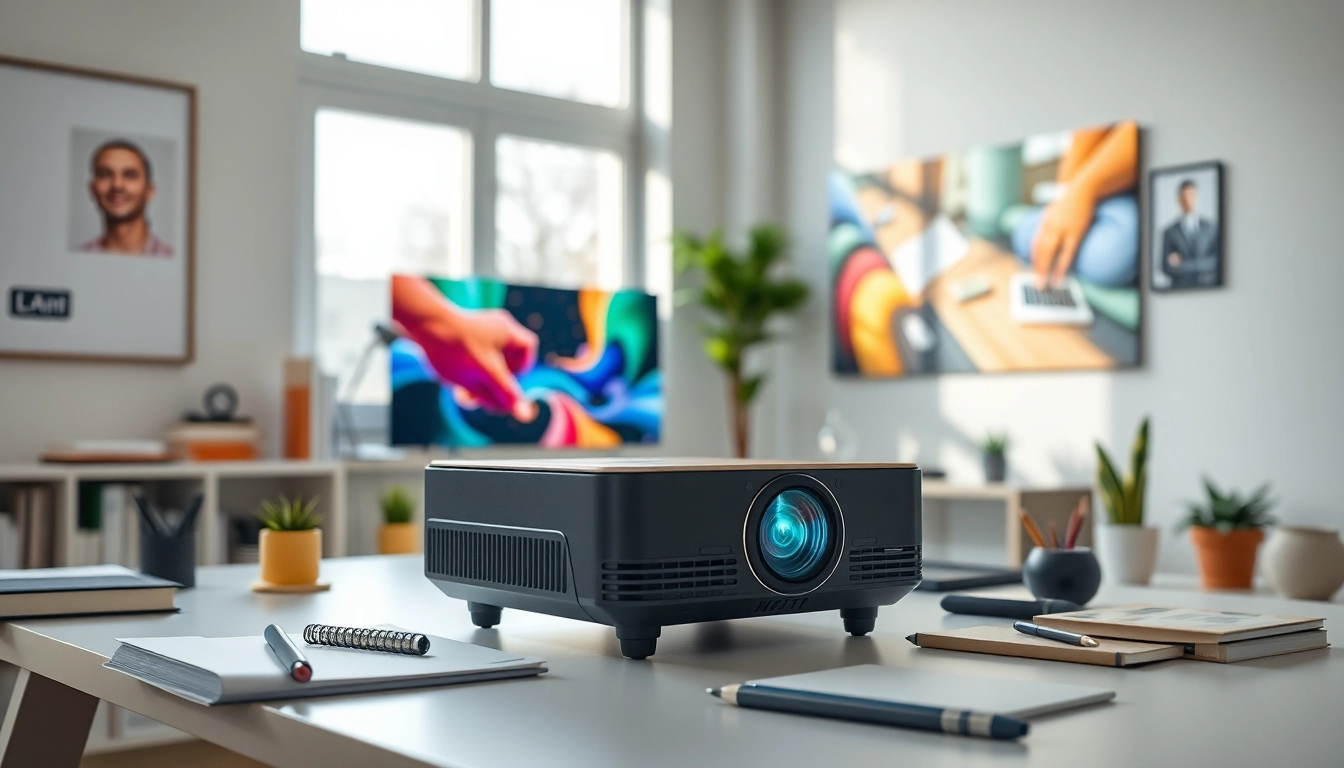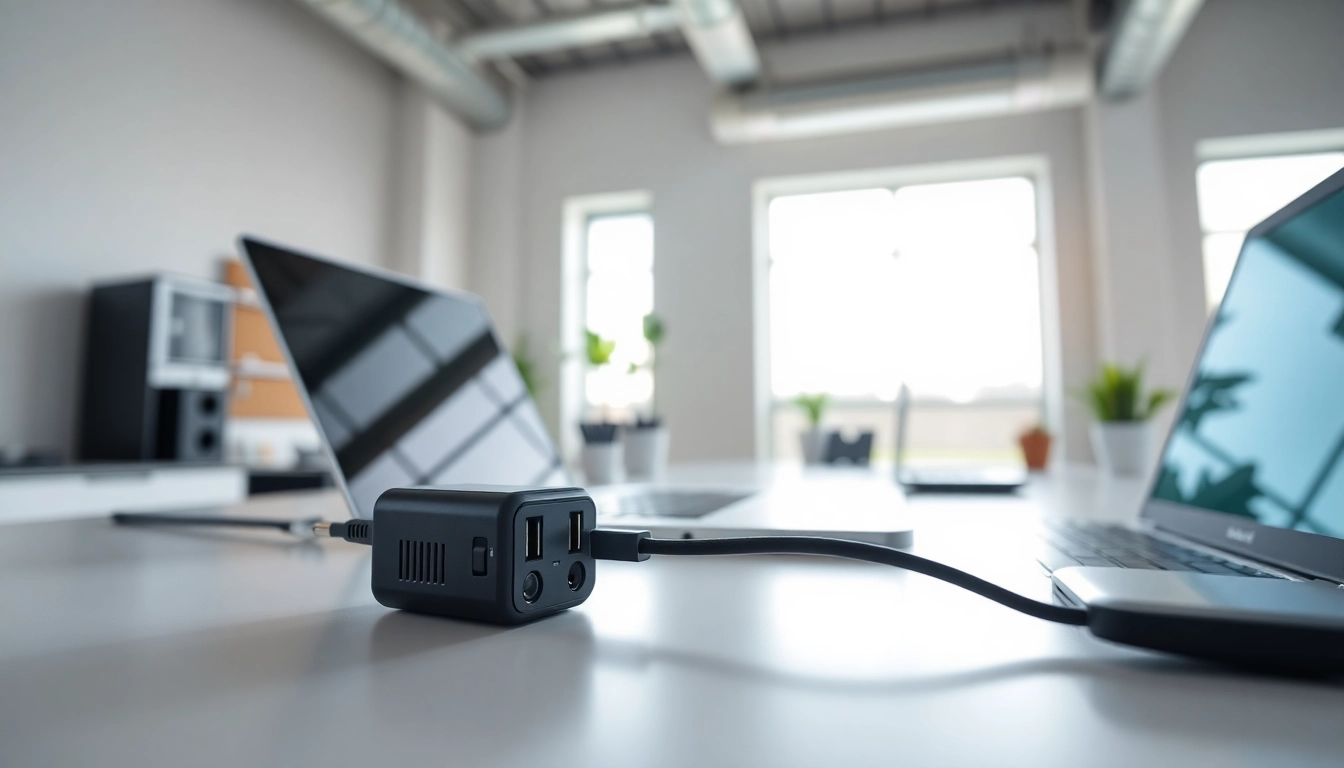Understanding the Basics of Projector Technology
What is a Projector?
A Projector is an optical device that projects an image or video onto a surface, typically a screen, using light. The function of a projector is to create larger-than-life visuals, making them an invaluable tool for presentations, home entertainment, and educational purposes. Modern projectors utilize various technologies such as LCD (Liquid Crystal Display), DLP (Digital Light Processing), and LCoS (Liquid Crystal on Silicon) to deliver high-quality images. Understanding how these technologies work forms the foundation for selecting and operating a projector effectively.
Different Types of Projectors
Projectors can be categorized based on their technology, configuration, and intended use. Here are a few types:
- LCD Projectors: Utilize liquid crystal displays to produce images. They are known for their excellent color reproduction and brightness, making them suitable for bright environments.
- DLP Projectors: Use a digital micromirror device to create images, providing smooth motion and better contrast ratios. They are often preferred for movies and dynamic presentations.
- LCoS Projectors: Combine aspects of both LCD and DLP, offering higher resolutions and superior image quality, particularly for detailed graphics.
- Short-Throw Projectors: Designed to project large images from a short distance, ideal for small spaces.
- Long-Throw Projectors: Require a greater distance to project images but are good for large venues.
Key Specifications to Consider
When selecting a projector, understanding key specifications is essential to make an informed decision. Some critical factors include:
- Brightness: Measured in lumens, this indicates how bright the image will be. Higher lumens are necessary for well-lit rooms.
- Resolution: The clarity of the image is designated in pixels. Higher resolutions such as Full HD (1920×1080) or 4K (3840×2160) provide sharper images.
- Contrast Ratio: This is the difference between the darkest black and the brightest white an image can display. A higher contrast ratio improves image depth.
- Connectivity: Check for HDMI, USB, and wireless options to ensure compatibility with your devices.
- Portability: For users who plan to transport their projectors, weight and size become significant factors.
Choosing the Right Projector for Your Needs
Home Entertainment vs. Business Use
Choosing the right projector starts with understanding its intended purpose. For home entertainment, you need a projector with high resolution and contrast to enjoy movies and games. Look for features like color accuracy, aspect ratios that match your screen, and larger brightness levels to overcome ambient light. On the other hand, business projectors typically emphasize portability and connectivity, as well as brightness to overcome room lighting. The decision-making process should include evaluating your typical viewing environment, required features, and available spending budget.
Short-throw vs. Long-throw Projectors
The choice between short-throw and long-throw projectors affects your space planning significantly. Short-throw projectors can be placed close to the screen, making them perfect for smaller rooms where space is limited. They reduce shadow interruptions during presentations, allowing for a more immersive experience. In contrast, long-throw projectors are suitable for larger venues, as they can project larger images from distances that can exceed 10 feet. Understanding your space and setup is critical for maximizing the utility of your projector.
Portability and Installation Considerations
Depending on your needs, the projector’s weight and installation capabilities can vary. Portable projectors are designed for mobile use; they are usually lightweight and come with built-in batteries. These projectors can be ideal for traveling businesses, impromptu presentations, or home movie nights at a friend’s house. In contrast, installation projectors may require mounting fixtures, longer throw distances, and complex wiring relations. Knowing the nature of your usage can guide you in picking the option best suited to your lifestyle and purpose.
Optimizing Projector Performance in Various Environments
Lighting Conditions
Lighting significantly impacts projector performance. In darker environments, lower-lumen projectors can be used effectively without compromising on image quality. However, in brightly lit spaces, high-brightness projectors are essential to overcome ambient light. When planning a presentation, consider using blackout curtains or screens to enhance the overall visibility. Experimenting with different positions and angles can also create optimal viewing conditions.
Screen Size and Distance
The size of the projection screen and the distance between the projector and the screen are crucial determinants of the viewing experience. Ideally, the projector should be positioned to allow for a large enough image without distortion or loss of detail. Most guidelines suggest a projection distance that is 1.5x to 2.5x the width of the screen. Using calculators found on projector manufacturers’ websites can help identify the correct distance for your specific model.
Sound Integration and Surrounding Setup
Projector sound quality often doesn’t match that of premium audiovisual systems. Hence, integrating external sound systems or speakers can substantially improve the experience, especially for movies or presentations. Ensuring proper speaker placement can enhance audio clarity and depth, creating a more engaging environment. Many projectors come equipped with audio outputs for easy system connection, enabling seamless sound integration.
Advanced Features to Look for in a Projector
Wireless Connectivity Options
In an age of digital convenience, wireless connectivity has become a desirable feature. Projectors that offer Wi-Fi capabilities allow users to connect smartphones, tablets, and laptops without cumbersome cables. Look for projectors with built-in applications or support for wireless streaming protocols like Miracast or AirPlay to enhance the ease of use similar to standard presentations with minimal fuss.
Smart Features and User Interfaces
Smart projectors incorporate built-in apps, streamlined user controls, and intuitive interfaces that improve the overall experience. Features like on-screen menus, remote control accessibility, and integration with voice assistants can greatly enhance usability. For example, some projectors allow you to stream content directly from paid streaming services or plug in to your network for easier access to shared files.
Resolution and Image Quality Enhancements
Image quality can make or break your projector’s performance. Look for projectors that support higher resolution outputs and advanced image processing technologies such as HDR (High Dynamic Range). These improvements provide more vibrant colors and deeper contrasts, significantly enhancing both graphic representational quality and video playback enjoyment. The key is to ensure that your source material—whether it’s a presentation or video content—matches the projector’s capabilities to harness its full potential.
Maintenance and Troubleshooting Common Projector Issues
Regular Cleaning and Care Tips
To prolong the life of your projector and maintain optimal performance, regular maintenance is essential. This includes cleaning the lens, filters, and ensuring ventilation ports are clear. Dust buildup can degrade image quality and cause overheating. Periodically checking the user manual for specific care instructions is advisable for various projector models, and investing in appropriate cleaning kits can be beneficial.
Troubleshooting Image and Connectivity Problems
Despite best efforts, technical issues may arise. Common problems such as image distortion, flickering, or connectivity issues can often be resolved simply. Checklist items include checking all cable connections, recalibrating the image settings, and ensuring that the correct source input is selected. If issues persist, consider consulting the troubleshooting section of the user manual or exploring online forums for user experiences and solutions.
When to Seek Professional Repair Services
Sometimes, projector issues may require professional help. If you experience malfunctioning components, persistent over-heating, or factory settings that don’t rectify an issue, it may be time to reach out for repair help. Consider existing warranties or repair services that can restore your projector to optimal working condition without compromising quality.




